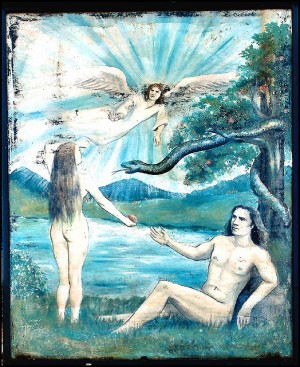Should we Adam and Eve it?
Lynn Williamson
Adam and Eve, the first humans, the basis of the human race, the cornerstones of a Biblical understanding of God’s creation – or are they?

Is there more than one way of thinking of Adam and Eve, and does it actually matter whether they existed or not?
One thing is sure, there is no universal agreement on this topic. Many Christians believe in Adam and Eve as the literal first humans, created by God as Homo Sapiens, who lived in a literal Garden of Eden.
Others though are less convinced by the idea that there is a specific intention to give an ‘historic’ account in Genesis. Famously CS Lewis spoke of parts of the Genesis story as ‘fabulous’ – by which he meant ‘like a fable’ rather than ‘wonderful’.
Then there’s the question of whether there is a divide between faith and science – it’s certainly difficult to believe in a literal Adam and Eve, and accept the theory of evolution. On that basis some think there must be a way of understanding Adam and Eve in the light of the evolutionary process.
So what are the options for understanding Adam and Eve?
1) Literal
According to a literal approach, Adam and Eve really existed, made out of earth by God in his own ‘likeness’. This understanding effectively denies the legitimacy of the evolutionary theory, and leaves people who believe in early forms of pre-humans (like Neanderthals) with a bit of explaining to do. It does however seem to fit well with a traditional understanding of original sin, and thus the need for redemption through Christ’s death on the cross.
2) The missing link
This way of looking at the story accepts the idea of Adam and Eve as literal individual people, or at least as representative individuals – but suggests that God created them via the process of evolution, making them deliberately by means of intelligent design. On these lines then, Adam and Eve are the ‘missing link’ the point at which the pre-human species turned into the first humans.
3) Universal Parable
While maintaining an acceptance that God created humanity, this approach takes the route of saying that the account of Creation in Genesis is actually to be read as a parable rather than a ‘history’ account. It is a way of explaining what happened, using language which was understood at the time of writing, and conveniently explains why we have two different takes on the same story in the first two chapters of Genesis.
4) Adam as an image of Israel
This approach has the creation account as a work of theology – setting out the place of Israel in God’s world. According to this way of thinking Adam is a way of understanding the failure of Israel to reach its potential, not a way of telling the story of the beginning of the world.
But does it matter whether we accept any one of these accounts rather the other? Over the centuries, believers of different stripes have taken different approaches to the question of who Adam and Eve were – and built or reconfigured their theology accordingly.
Where do you stand on this? Let us know in the comments….
Latest Blogs

Bible
Why is the Bible Called The Bible? (A Simple Explanation)
Ever wondered where the name "Bible" comes from? Discover the simple meaning behind the word and why it's called 'the books'.

Bibles
The ERV (Easy-to-Read Version): Your Questions Answered
What is the ERV Bible? Is it accurate? Our simple guide answers the top questions about the Easy-to-Read Version and compares it to the NIV and NLT.

Bible
I’m a New Christian, Where Do I Even Start with the Bible?
Feeling excited but overwhelmed about reading the Bible for the first time? This simple, friendly guide for new Christians shows you exactly where to start, what to read first, and how to understand it.

Bibles
NLT vs. KJV: A Guide to Readability and Tradition
Comparing the NLT vs. the KJV Bible? Our simple guide explains the key differences in language and style to help you choose the best translation for you.

Bibles
ESV vs. KJV: A Guide to Choosing Your Literal Bible Translation
Comparing the ESV vs. the KJV Bible? Our guide explains the key differences in language and accuracy to help you choose the best word-for-word translation.

Bible
Bible Translation Reading Levels Explained (A Simple Guide)
Understand Bible translation reading levels easily. Our guide explains the reading age for NIV, NLT, ESV, KJV & more to help you choose the right Bible.
